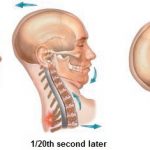DRIVER ELECTRONIC DEVICE USE
By Matthew J. DeGaetano, DC and Dr. Raymond Tolmos, DC, DABCI
Certified in Personal Injury
National Highway Traffic Safety Administration: The percentage of passenger vehicle drivers text-messaging or visibly manipulating handheld devices remained constant at 2.2 percent in 2015.
Driver handheld cell phone use decreased from 4.3 percent in 2014 to 3.8 percent in 2015 (Figure 1); this was not a statistically significant decrease.

These results are from the National Occupant Protection Use Survey (NOPUS), which provides the only nationwide probability-based observed data on driver electronic device use in the United States. The NOPUS is conducted annually by the National Center for Statistics and Analysis of the National Highway Traffic Safety Administration.
Results: Drivers Holding Phones to Their Ears While Driving The percentage of drivers holding cell phones to their ears while driving decreased from 4.3 percent in 2014 to 3.8 percent in 2015 (Table 1).

This rate translates into an estimated 542,000 passenger vehicles driven by people using handheld cell phones at a typical daylight moment in 2015. It also translates into an estimated 6.9 percent of the vehicles whose drivers were using some type of phone (either handheld or handsfree) at a typical daylight moment in 2015. Please refer to the section “Estimating Drivers on the Road and Hands-Free Cell Phone Users” for more details on these two estimates. The 2015 NOPUS found that handheld cell phone use continued to be higher among female drivers than male drivers (Figure 2). It also found that handheld cell phone use continued to be highest among 16- to 24-year-old drivers and lowest among drivers 70 and older (Figure 3).
In 2015 alone, 3,477 people were killed, and 391,000 were injured in motor vehicle crashes involving distracted drivers.
During daylight hours, approximately 660,000 drivers are using cell phones while driving. That creates enormous potential for deaths and injuries on U.S. roads. Teens were the largest age group reported as distracted at the time of fatal crashes.
More statistics on distracted driving and other risky driving behaviors are available.
NHTSA leads the fight nationally against distracted driving by educating Americans about its dangers and partnering with the States and local police to enforce laws against distracted driving that help keep us safe.
NHTSA’s campaigns and public service announcements make the case to Americans that safe driving means driving without distractions. You’ve likely seen or heard our public service announcements but we’re also on Facebook and Twitter sharing stories and tips to help save lives.
The foundation of NHTSA’s efforts on distracted driving and other risky driving behaviors is our partnership with the States and local police. The States determine laws affecting distracted driving, but NHTSA provides Federal investments in the locally driven strategies that address the States’ specific needs. One of the highlights of this relationship comes during April’s Distracted Driving Awareness Month, which pairs a national advertising campaign with a law enforcement crackdown called U Drive. U Text. U Pay.
Texting while driving is a growing trend, and a national epidemic, quickly becoming one of the country’s top killers. Drivers assume they can handle texting while driving and remain safe, but the numbers don’t lie.
Texting While Driving Causes:
1. 1,600,000 accidents per year – National Safety Council
2. 330,000 injuries per year – Harvard Center for Risk Analysis Study
3. 11 teen deaths EVERY DAY – Ins. Institute for Hwy Safety Fatality Facts
4. Nearly 25% of ALL car accidents
Texting While Driving Is:
1. About 6 times more likely to cause an accident than driving intoxicated
2. The same as driving after 4 beers – National Hwy Transportation Safety Admin.
3. The number one driving distraction reported by teen drivers
Texting While Driving:
1. Makes you 23X more likely to crash – National Hwy Transportation Safety Admin.
2. Is the same as driving blind for 5 seconds at a time – VA. Tech Transportation Institute
3. Takes place by 800,000 drivers at any given time across the country
4. Slows your brake reaction speed by 18% – Human Factors & Ergonomics Society
5. Leads to a 400% increase with eyes off the road






